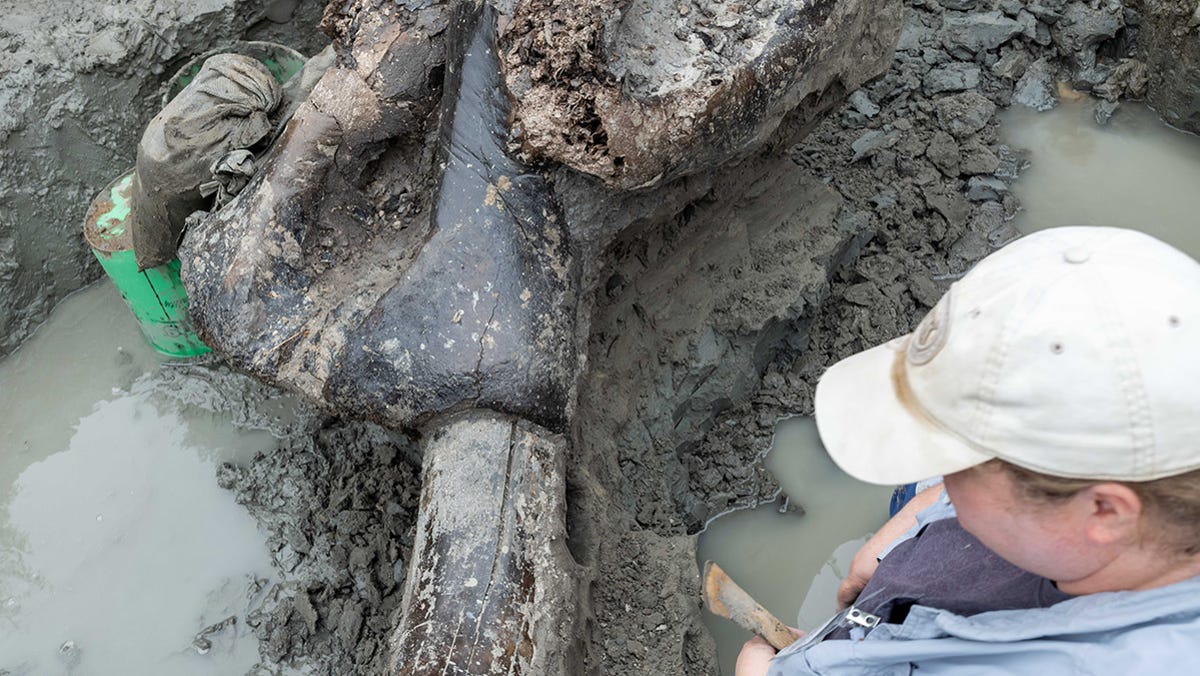Mastodon skull discovered in Iowa; researchers seek proof of human interaction
Uncovered in southern Iowa, this represents the state’s first well-preserved mastodon find.
Archaeologists in Iowa have stumbled upon an ancient mastodon skull that dates back to a period when early humans inhabited the Earth.
Found in the southern region of Iowa, this represents the state’s first well-preserved mastodon according to the Office of the State Archaeologist at the University of Iowa. A group of scientists and local volunteers recently spent twelve days digging at the site, uncovering “multiple mastodon bones,” largely from the skull.
Through radiocarbon dating, researchers determined that the specimen is approximately 13,600 years old, indicating it lived during the time when the earliest humans were present and hunting in the area, as stated by the university.
The next step for the researchers will be to analyze the bones for any signs of interactions with humans.
The mastodon skull is believed to be 13,600 years old
Mastodons, sizable creatures akin to elephants and mammoths, roamed North America for about 3.5 million years until around 10,500 years ago.
A Wayne County resident contacted John Doershuk, the state archaeologist for Iowa, in 2022 after discovering an unusually lengthy bone lodged in a creek bed located on private land.
The bone was identified as a mastodon femur, leading archaeologists to further explore the site last fall. During that investigation, they also found a broken tusk sticking out of the creek bed, likely still connected to the mastodon’s skull.
After receiving funding for an additional excavation, the team returned this month to “carefully excavate the skull and several additional mastodon bones, likely all from the same animal,” as noted in a press release from the University of Iowa.
Researchers are investigating signs of human interaction with the mastodon
The twelve-day excavation also unearthed numerous human-made objects, including stone tools.
Although the tools were dated to a few thousand years post the mastodon skull, archaeologists were encouraged by the discovery, marking the first evidence of “human presence in the creek drainage.”
Currently, the researchers hope that further archaeological discoveries, along with detailed recording of the bones’ positions and orientations, could reveal signs of “human interaction” with the mastodon, as well as the circumstances surrounding how the creature ended up in the creek bed.
“We really hope to uncover evidence of human contact with this animal—perhaps the projectile points and knives that were used in its hunting and initial processing,” Doershuk noted in a statement. “There might even be identifiable cut marks on the bones themselves.”
Similar fossil discoveries
This discovery is the most recent in a series of prehistoric finds throughout the United States.
Earlier this month, a man in Mississippi uncovered a mammoth tusk, an uncommon find for the region. Additionally, a Florida man discovered a 4-foot mastodon tusk submerged in the ocean while searching for fossils near Venice.
In May 2023, coal miners in North Dakota uncovered a seven-foot-long mammoth tusk buried for millennia near Beulah, approximately 80 miles northwest of Bismarck. Following a twelve-day excavation, scientists found more than twenty bones from the skeleton, which were among the most complete mammoth remains ever uncovered in the state.
Viewing the Iowa mastodon bones
After the University of Iowa scientists analyze and preserve the skull and related bones, they are planned to be included in a new exhibit at the Prairie Trails Museum in Corydon.

